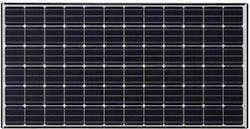Panasonic HIT solar module achieves world's best output temperature coefficient
Panasonic (Osaka, Japan) says that it has achieved the world's best output temperature coefficient for nonconcentrating silicon photovoltaic modules, at -0.258%/°C for mass-produced silicon photovoltaic modules. The closer the coefficient is to zero, the more efficient the photovoltaic is at high temperatures.
Up until now, the record output temperature coefficient stood at -0.29%/°C. The current efforts yielded a technical improvement of 0.032% to -0.258%/°C at the mass production level, highlighting the positive temperature characteristics of heterojunction solar cells.
Modules are composed of solar cells whose conversion efficiency degrades as the temperature rises, thereby reducing the output. The output temperature coefficient indicates the degree of such decline. A conventional silicon solar cell's output temperature coefficient is about -0.50%, which denotes a decline of 0.50% in the conversion efficiency as the module temperature rises by 1°C. For instance, at a module temperature anticipated in the summer months (75°C), the conversion efficiency will decrease by 25% in comparison to the environment at 25°C. Panasonic's new HIT modules will almost halve the decline in the conversion efficiency.
The current results were achieved by further improving Panasonic's heterojunction fabrication approach—the technology for solar-cell junction formation in which the crystalline silicon base surface is covered with an amorphous silicon layer. This technology has improved passivation to compensate for the many flaws around the silicon base surface area. This technology is the biggest feature of HIT, and this improved technology has been incorporated in the product, says Panasonic.
The company will continue to work on technology development and mass commercialization of this technology with the aim of achieving improvements in efficiency and reliability.
Source: http://news.panasonic.com/global/press/data/2017/05/en170524-2/en170524-2.html
About the Author
John Wallace
Senior Technical Editor (1998-2022)
John Wallace was with Laser Focus World for nearly 25 years, retiring in late June 2022. He obtained a bachelor's degree in mechanical engineering and physics at Rutgers University and a master's in optical engineering at the University of Rochester. Before becoming an editor, John worked as an engineer at RCA, Exxon, Eastman Kodak, and GCA Corporation.

